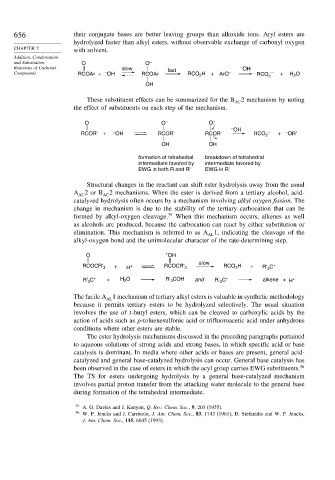Page 674 - Advanced Organic Chemistry Part A - Structure and Mechanisms, 5th ed (2007) - Carey _ Sundberg
P. 674
656 their conjugate bases are better leaving groups than alkoxide ions. Aryl esters are
hydrolyzed faster than alkyl esters, without observable exchange of carbonyl oxygen
CHAPTER 7 with solvent.
Addition, Condensation
and Substitution O O –
Reactions of Carbonyl slow fast – OH
Compounds RCOAr + – OH RCOAr RCO H + ArO – RCO 2 – + H O
2
2
OH
These substituent effects can be summarized for the B 2 mechanism by noting
AC
the effect of substituents on each step of the mechanism.
O O – O –
– OH
RCOR' + – OH RCOR' RCOR' RCO 2 – + – OR'
OH OH
formation of tetrahedral breakdown of tetrahedral
intermediate favored by intermediate favored by
EWG in both R and R' EWG in R'
Structural changes in the reactant can shift ester hydrolysis away from the usual
A 2orB 2 mechanisms. When the ester is derived from a tertiary alcohol, acid-
AC
AC
catalyzed hydrolysis often occurs by a mechanism involving alkyl oxygen fission. The
change in mechanism is due to the stability of the tertiary carbocation that can be
formed by alkyl-oxygen cleavage. 35 When this mechanism occurs, alkenes as well
as alcohols are produced, because the carbocation can react by either substitution or
elimination. This mechanism is referred to as A 1, indicating the cleavage of the
AL
alkyl-oxygen bond and the unimolecular character of the rate-determining step.
O + OH
slow
+ + RCO H + +
RCOCR' 3 H RCOCR' 3 2 R' C
3
R' C + + H O R' COH and R' C + alkene + H +
2
3
3
3
The facile A 1 mechanism of tertiary alkyl esters is valuable in synthetic methodology
AL
because it permits tertiary esters to be hydrolyzed selectively. The usual situation
involves the use of t-butyl esters, which can be cleaved to carboxylic acids by the
action of acids such as p-toluenesulfonic acid or trifluoroacetic acid under anhydrous
conditions where other esters are stable.
The ester hydrolysis mechanisms discussed in the preceding paragraphs pertained
to aqueous solutions of strong acids and strong bases, in which specific acid or base
catalysis is dominant. In media where other acids or bases are present, general acid-
catalyzed and general base-catalyzed hydrolysis can occur. General base catalysis has
been observed in the case of esters in which the acyl group carries EWG substituents. 36
The TS for esters undergoing hydrolysis by a general base-catalyzed mechanism
involves partial proton transfer from the attacking water molecule to the general base
during formation of the tetrahedral intermediate.
35 A. G. Davies and J. Kenyon, Q. Rev. Chem. Soc., 9, 203 (1955).
36
W. P. Jencks and J. Carriuolo, J. Am. Chem. Soc., 83, 1743 (1961); D. Stefanidis and W. P. Jencks,
J. Am. Chem. Soc., 115, 6045 (1993).

